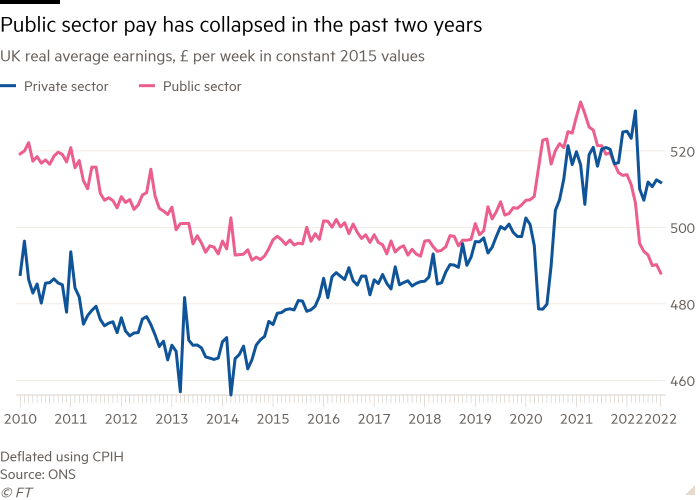The UK government is confronting a “winter of discontent” in public services. In response, it insists that it cannot afford higher pay and seeks to limit the right of public servants to strike. This may work politically. But it does not make sense economically. Public sector pay should be set at levels needed to attract and motivate the required staff. An upsurge in inflation does not change that logic.
Since the Conservatives won power in May 2010, overall real average pay (including bonuses) had risen by 5.5 per cent in the private sector by September 2022, but fallen by 5.9 per cent in the public sector. Startlingly, between January 2021 and September 2022, average real pay in the private sector fell by 1.5 per cent, but in the public sector pay fell by 7.7 per cent. In fact, all the decline in real public sector pay since 2010 has occurred in the past two years.
Such a large cut in real public sector pay could not have occurred without high inflation. But would one have wanted to reduce real pay in the absence of a rise in the price level? The answer is: yes. The UK has suffered a big deterioration in its “terms of trade”. Thus, the prices of its imports have risen sharply against those of its exports. The UK is poorer than it would have been if the rises in energy prices, above all, had not happened. Some of this adjustment in real incomes should fall on wages. Thus, some fall in real earnings is neither surprising nor inappropriate. Inflation has merely made it possible to implement.
Yet even if some fall in real earnings in the economy makes sense, why should the public sector’s fall be far greater than that in the private sector?
One might argue that control over public sector wages is an effective way to prevent a wage-price spiral, that government cannot afford to pay public sector workers any more, or that inflation is an opportunity to reduce excessive levels of public sector pay, especially when one takes perks, notably generous pensions, into account.
None of these arguments has merit.
On the first, Ben Zaranko of the Institute for Fiscal Studies, notes that “it is difficult to see how an increase in public sector wages could directly contribute to a wage-price spiral”, given the lack of prices in the public sector. Nor, he notes, can one argue that public sector pay is leading inflation, since it is falling far behind. Above all, policy on pay will not lower inflation. This demands macroeconomic measures.

On the second, the decision by government not to raise pay in line with wages in the private sector is not because it cannot afford to do so. Taxes could be raised if the will were there. It is in effect a political decision to make public sector employees pay for the government’s unfunded promises.
On the last argument, as the IFS noted in its October 2022 Green Budget, average pay in the public sector is higher than in the private sector, but this advantage disappears when one takes worker characteristics — age, experience, qualifications and so forth — into account. Public sector workers are then paid slightly less than private sector ones. In fact, the ratio is now more unfavourable to public sector workers than at any point in the past 30 years. True, if one considers employer pension contributions as well, public sector employees were paid 6 per cent more than private sector ones on average in 2021. But this slight advantage is sure to erode further in 2022.

Above all, the test of whether pay is appropriate is whether it maintains services at the levels government has promised. It is clear that there are substantial shortfalls in key staff, as well as widespread concerns about their quality. Thus, data from NHS England “show a vacancy rate of 11.9 per cent as at September 30 2022 within the Registered Nursing staff group (47,496 vacancies). This is an increase from the same period in the previous year, when the vacancy rate was 10.5 per cent (39,931 vacancies).” Again, data show dramatic shortfalls in recruitment of teachers in such subjects as physics or design & technology.
As Chris Cook argues, the government should ask whether public sector pay is at a level that will sustain delivery of needed services. The country’s social fabric is fraying. In particular, ill health is damaging labour supply. If the government is not prepared to raise the required taxes, it should be honest about that. Letting inflation reduce real pay, while expecting services to be maintained, let alone improve, is plainly dishonest.
The government should keep pay in line with the private sector’s, especially where it has significant recruitment and retention problems. If this means it has to reopen spending plans that no longer make sense in today’s debased pounds, so be it. What is happening now may be penny wise, but it is pound foolish.






